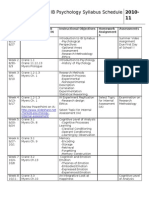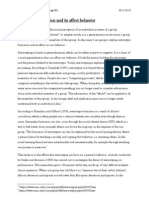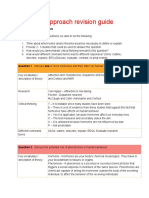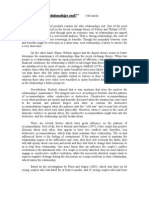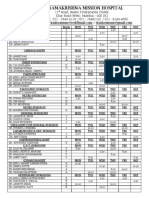IB Psychology HL Biological LOA
IB Psychology HL Biological LOA
Uploaded by
gfore3Copyright:
Available Formats
IB Psychology HL Biological LOA
IB Psychology HL Biological LOA
Uploaded by
gfore3Copyright
Available Formats
Share this document
Did you find this document useful?
Is this content inappropriate?
Copyright:
Available Formats
IB Psychology HL Biological LOA
IB Psychology HL Biological LOA
Uploaded by
gfore3Copyright:
Available Formats
Core: Biological Level of Analysis HL Psychology Exams 2011
June 6
HL Psycholo gy Syllabus
201 1
By Gabby
This text contains summarized notes for the Biological, Cognitive and Socio-Cultural levels of analysis, in addition to two options; abnormal and health psychology, and, qualitative research methods.
Core: Biological Level of Analysis HL Psychology Exams 2011
General Learning Outcomes
GLO Outline principles that define the biological level of analysis 1: Outline Give a brief account or summary Principles:
Animal research can provide insight into human behaviour (Martinez and Kesner) Biological correlates of behaviour exist Bidirectional relationship between bio and cog Biological research often takes a reductionist approach The active brain can be studied scientifically and non-invasively Cognitions, emotions & behaviours are products of the anatomy & physiology of our nervous system Patterns of Behaviour can be inherited through genetics
GLO Outline principles that define the biological level of analysis 2: Outline Give a brief account or summary Principles & Study:
Animal research can provide insight into human behaviour Martinez & Kesner (1991) The active brain can be studied scientifically and non-invasively Maguire et al (2000) Cognitions, emotions & behaviours are products of the anatomy & physiology of our nervous system Martinez & Kesner (1991)
GLO Discuss how and why particular research methods are used at the 3: biological level of analysis Discuss Offer a considered and balanced review that includes a range of arguments, factors or hypotheses. Opinions or conclusions should be presented clearly and supported by appropriate evidence.
Laboratory experiment: Laboratory research whereby as many aspects of the experimental situation are controlled as possible. Advantages: Enables isolation of causal factors, Excellent means of testing hypotheses. Disadvantages: Can lack ecological validity. Studies: Martinez & Kezner (1991)
Psychobiological research: 2
Core: Biological Level of Analysis HL Psychology Exams 2011 Studies the relationship between cognitive performance and Biology (cerebral events and structures). E.g. postmortem studies, animal studies, brain scan technology. Advantages: hard evidence of cognitive functions by relating them to physiological activity. Disadvantages: Expensive; risk of inferences about normal functions based on abnormal brain functioning. Studies: Maguire (2000)
Case studies: Intensive study of a single individual or group Advantages: Richly detailed information about individuals, including information about historical and current contexts, Very good for theory development Disadvantages: Small sample; questionable generalization to other cases Studies: HM
Quasi-Experiments & Natural Experiments: Advantages: Disadvantages: Studies: Maguire (2000)
GLO Discuss ethical considerations related to research studies at the 4: biological level of analysis Discuss Offer a considered and balanced review that includes a range of arguments, factors or hypotheses. Opinions or conclusions should be presented clearly and supported by appropriate evidence. General Ethical Issues
Right to withdraw Money Protection from Harm Money Deception Money Consent Money
Humans are also at risk to be affected psychologically in terms of embarrassment and low self-esteem. Ethical considerations must be taken into account the APA (American Psychological Association) Ethical Guidelines guides researchers to consider the implications of their research and deals with a number of methodological issues such as informed consent, deception, debriefing, the right to withdraw from the study, confidentiality as well as the protection of 3
Core: Biological Level of Analysis HL Psychology Exams 2011 participants from both physical and psychological harm. Genetic research Ethical Issues Open to abuse/misuse (Money), findings between genetic inheritance and behaviour and future lifestyle - do we or should we know our genetic future? (what responsibilities does the researcher have)
*It isnt enough to just list different considerations; a good answer should explain why.
Physiology and Behaviour
P&B Explain one study related to localisation of function in the brain. 1: Explain Give a detailed account including reasons or causes. Localization of function It has been determined that certain areas of the brain are primarily used for certain functions and determine specific behaviours. This also allows us to determine the effects of damage on these particular areas of the brain. reduced Studies: (Be sure to include a detailed AMRC)
Sperry (1968) Corpus collosum as a link between two hemispheres of the
brain Maguire et al (2000) Posterior hippocampus in spatial navigation
P&B Using one or more examples, explain effects of neurotransmission on 2: human behaviour. Explain Give a detailed account including reasons or causes. Neurotransmission Neurotransmitters are the bodys natural chemical messengers which transmit information from one neuron to another in the brain. The method by which these messages are sent is called neurotransmission. In neurotransmission, an electrical impulse sent down the axon in a neuron triggers the release of neurotransmitters from the terminal buttons. These neurotransmitters then cross the synaptic gap and pass on the message receptors on the next neuron. This activity between neurons is essential to the way humans think and behave. Studies:
Martinez & Kesner (1991) Acetylcholene and Memory
- Acetylcholine is neurotransmitter used to regulate memory.
Kasamatsu & Hirai (1999) Serotonin and Behaviour (Specifically
H or m Core: Biological Level of Analysis on HL Psychology Exams 2011 es ar e hallucinations) na- Seratonin is a neurotransmitter involved in functions including mood, tu appetite and sensory perception. ral ch P&B Using one or more examples, explain functions of two hormones in e 3: human behaviour. mi Explain Give a detailed account including reasons or causes. ca ls Hormones m es se ng Studies: er s Fernald & Gunner (2008) Cortisol and depression pr - Cortisol is a steroid hormone produced in the adrenal glands. Known as od the stress hormone. uc ed Young et al (1964) Testosterone & aggression by - Testosterone is an anabolic steroid. Testosterone is primarily secreted in th the testes of males and the ovaries of females, although small amounts are e also secreted by the adrenal glands. Testosterone plays a key role in bo physiological development in males and emotion. dy s en do P&B Discuss two effects of environment on physiological processes. cri 4: ne Discuss Offer a considered and balanced review that includes a range of sy arguments, factors or hypotheses. Opinions or conclusions should be presented st clearly and supported by appropriate evidence. e *Four studies in a 22 mark question and two studies in an 8 mark question. Only two m effects. th Before the 1960s, the brain was thought to be influenced only by genetics, and at therefore it was considered to be unchangeable. However, researchers have since ai demonstrated that the brain could change as a response to environmental input. d in Effect of Environment Enrichment on Brain Plasticity de ve Brain plasticity refers to the brains ability to rearrange the connections between lo its neurons; that is, the changes that occur in the structure of the brain as a result pi of learning or experience. The changes that take place are related to the ng challenges of the environment and therefore represent an adaptation to it. hu Plasticity can change the functional qualities of various brain structures, m depending on the regularity and types of new tasks that neurons are asked to an perform. ph ys Studies: iol og 5 y an d be
Core: Biological Level of Analysis HL Psychology Exams 2011
Maguire et al (2000) Posterior hippocampi and spatial navigation
- Taxi drivers were regularly engaged with spatial memory; the posterior hippocampi accommodated this task. - Because its a quasi experiment we can establish a correlation, however we cannot determine if the physiology is due to the environment or if the environment was chosen as a result of the physiology. Effect of Changing Environment on Hormone Secretion Another example of the effects of the environment on physiological processes demonstrated in research is the consequential increase and decrease of hormones. Whilst hormones are produced by the endocrine system in the body (biological factor), it has been suggested that their production can be influenced by environmental factors such as income, family relationships and career success. Studies:
Fernald & Gunner (2008) Poverty and cortisol production
- Cortisol is a steroid hormone produced in the adrenal glands. Known as the stress hormone. - Poverty stress low levels of cortisol Conclusion There is strong evidence to suggest that environmental factors influence our physiology and its processes. Understanding the effects our environment has on our physiology enables us to make informed decisions and take precautions to increase our quality of life.
P&B Examine one interaction between cognition and physiology in terms of 5: behaviour. Examine Consider an argument or concept in a way that uncovers the assumptions and interrelationships of the issue.
Amnesia Define amnesia two different types Break down the interaction.
Studies: Interaction between memory processing and hippocampal damage: Clive Wearing (Amnesia) Sacks, HM (Amnesia) Milner Hippocampus - Retro past - Antero Future Evaluate two relevant studies. 6
Core: Biological Level of Analysis HL Psychology Exams 2011 Evaluate Make an appraisal by weighing up the strengths and limitations. Evaluate in terms of: Reductionism Ethical issues (research) Methodological issues (research) Generalisability - Gender differences in the interaction - Cultural differences in the interaction
P&B Discuss the use of brain imaging technologies in investigating the 6: relationship between biological factors and behaviour. Discuss - Offer a considered and balanced review that includes a range of arguments, factors or hypotheses. Opinions or conclusions should be presented clearly and supported by appropriate evidence.
*Make sure you evaluate the BIT and explain (using a study) how it has identified a relationship between bio and cognition. Modern technology is now extensively used in neuropsychology because it provides an opportunity to study the active brain non-invasively. This allows researchers to see where specific brain processes take place and enables them to study localization of function in the living brain. BIT are non invasive techniques they dont cause irreversible harm Have stopped invasive techniques such as: ablation, lesioning and electrode insertion. Structural Overall structure of the brain, frozen image doesnt show activity Functional used for neurological and cognitive research, moving image of brain activity regions. Can see where the brain is metabolizing energy.
EEG (Electroencephalogram) Electro-chemical signals are the basis of communication between neurons and these can be recorded by attatching electrodes at the scalp. Two measurements are commonly used to analyze an EEG record. The amplitude, or size of the waves, and the number of waves per second. Broadly speaking the more relaxed a person is the greater the amplitude and the lower the frequency of the waves. The lower the amplitude and the greater the frequency then the more likely it is that the person is in an excited state. Studies: Davidson (2004)
PET (Positron Emission Topography) A PET scan monitors glucose metabolism in the brain. The patient is injected with a harmless dose of radioactive glucose, and the radioactive particles emitted by the glucose are detected by the PET scanner. The scans produce coloured maps of brain activity. 7
Core: Biological Level of Analysis HL Psychology Exams 2011 Studies: Reine et al (1997)
FMRI (functional Magnetic Resonance Imaging) fMRIs involve measuring changes in oxygen levels in the brain which is an indicator of blood flow, which is also a property of cortical activity. The amount of oxygen carried in the blood affects the bloods magnetic properties. FMRI can detect the functionally induced changes in blood oxygenation. An fMRI provides three dimensional pictures of the brain structures, using magnetic fields and radio waves. Studies: Macguire et al (2000)
Genetics and Behaviour
G&B 1: With reference to relevant research studies, to what extent does genetic inheritance influence behaviour? To What Extent Consider the merits or otherwise of an argument or concept. Opinions and conclusions should be presented clearly and supported with appropriate evidence and sound argument. Intelligence Both genetics and environment play crucial role o Poverty tends to correlate with low IQ Meta-analysis of 111 studies found highest correlation for IQ was kinship (Bouchard & McGue, 1981) Minnesota Twin Study (Bouchard et al., 1990) o MZ twins raised together compared to MZ twins raised apart longitudinal study o Estimate that heritability accounts for about 70% of intelligence Criticism Media coverage to recruit participants - possible sample bias Ethical concerns about how he reunited the twins who were reared apart No control over how often the twins reared apart visited each other prior to study Equal environment assumption - cannot assume twins raised together experience same environments (e.g. treatment from parents, experience with friends and peers in school and at home)
th ey ev ok e di sg us t fu rt he r pr o Adoption studies (Scarr & Weinberg, 1977; Horn et al., 1979) m o No significant difference found in correlations despite adoptive parents being ot wealthy, white and with high IQ and adopted children being from poor es backgrounds su G&B 2: Examine one evolutionary explanation of behaviour rvi Examine Consider an argument or concept in a way that uncovers the va assumptions and interrelationships of the issue. l DISGUST KE Promotes survival (Fessler, 2006) Y Introduce the idea of mechanisms of behaviour ST Confirmed by online survey that found participants had the strongest U disgust DI reaction to stimuli which threatened the immune system (Curtis et al., 2004) ES Has also been related to biological preparedness and phobias because animals that elicit a disgust response can be poisonous and avoiding these creatures because FESSLER et.al. (2006) LINK to evolutionary theory of disgust: EXAMPLE: as the first trimester women have the strongest disgust mechanism this fits with evolutionary theory since when their immune system is weakest (to protect foetus from rejection) they require the strongest level of protection from any contaminated food and thus those women with the genes for the strongest mechanism for disgust during the first trimester have survived and their genes have passed from generation to generation. CURTIS et.al. (2004) LINK to evolutionary theory of disgust EXAMPLE: women stronger reaction than men is of evolutionary significance as women have a greater involvement In reproduction and need to protect the foetus age older persons less involved in reproduction BUT older people have greater experience and have learned coping mechanisms and strategies to respond in different ways to problematic items...using analysis of setting etc. Alternative Views eg Rozin argues that disgust is culturally acquired ie learnt behaviour **see notes EKMAN once disagreed with evolutionary theories BUT now is convinced that six emotions are universal including disgustsee G:Drive doc from BJ txt. Further evidence in support of evolutionary explanation GENERAL EVALUATION of Evolutionary theories: 9
Core: Biological Level of Analysis HL Psychology Exams 2011
Core: Biological Level of Analysis HL Psychology Exams 2011 Research is speculative as little is known about human ancestors Reductionist complex ideas simplified Experimentation problematic thus cause and effect not shown Determinist tendency to ignore conflicting research, Hayes (2005) confirmation bias CONCLUSIONthere is considerable evidence to support the view that the mechanism for disgust has been advantageous to human survival and has evolved over millions of years , however, the impact of the environment on our disgust mechanism should not be underestimated. Eg vegemite! G&B 3: Discuss ethical considerations in research into genetic influences on behaviour Discuss - Offer a considered and balanced review that includes a range of arguments, factors or hypotheses. Opinions or conclusions should be presented clearly and supported by appropriate evidence. PROTECTION from HARM: genetic research attempts to uncover whether an individual has a particular genetic make-up, whether you have the genes for xor more accurately the pre-disposition for a psychological disorder eg schizophrenia. Heston found that 10% of adopted children whose biological mothers had been diagnosed with S developed S compared to only 1% of adopted children with bio mothers who were not diagnosed with S. Counselling: child if told should be informed that this is not a certainty, they may have a pre-disposition but it is NOT determined, they are not necessarily going to develop the disorder BUT this raises a key issue with genetic research we dont know what we might findeg misattributed paternity, may find that this is not your child??? We also have many recessive genes which may be for unfortunate characteristicsie carry one of the genes for depression Caspis 5HTT short allele, may have only one not two of these what are the risks?? Of developing depression? Should this information be made public : who?? Individual, parent, school, employer, insurance company . False positives??? Consent = Informed!! But hard to be informed in such a grey area. Who consents = child needs parental consent, what about wider family what you find out may affect siblings etc and then the wider community eg Aboriginal community decision as wider implications for the community. In the Money study David Rheimers parents consented and even asked for Moneys help BUT Money may have misled them about how easy it would be to reassign their childs gender identity and they were not aware of the practise sexual behaviour Confidentiality/privacy = Should this information be made public : who?? Individual, parent, school, employer, insurance company . Heston did not reveal the names of the adopted children but may have obtained access to their medical and psychological records without their consent. Money did not reveal the name of David Rheimer. Right to withdraw = not easy for children to do this when adults are in 10
Core: Biological Level of Analysis HL Psychology Exams 2011 control of researchMoney example.
Unintended consequences of research = Charles Murrays use of IQ and race in America to mislead and feed into racist debates. Also the media misuse of Hamers research into the Xq28 gene.misreported as finding a gay gene. Stigmatizing if someone is labelled with a pre-disposition they may not be employed or get life insurance or it may lead to a self-fulfilling prophecy..interpret all unusual behaviour as psychotic and result in further disturbed behaviour etc. Self-awareness similar effects on an individual.do you want to know you carry the genes for Alzheimerseffect on parents if passed certain genes on to children
11
You might also like
- IB Psychology List of All Past Exam QuestionsDocument4 pagesIB Psychology List of All Past Exam QuestionsArina Kocherga50% (6)
- Research Methods - Revision Lab, Field and Natural StudiesDocument10 pagesResearch Methods - Revision Lab, Field and Natural StudiesSupriyaa Chordia50% (2)
- IB Psychology ERQsDocument15 pagesIB Psychology ERQsMichelle Karam LondoñoNo ratings yet
- Paper 1 Study Guide For IB PsychologyDocument24 pagesPaper 1 Study Guide For IB PsychologyIsabelle Fellay100% (4)
- PSYCHOLOGY Paper 1 PDFDocument36 pagesPSYCHOLOGY Paper 1 PDFmostafa barakatNo ratings yet
- Extended Essay in Psychology ChecklistDocument3 pagesExtended Essay in Psychology Checklisttriptirathore100% (1)
- AQA Psychology BRILLIANT MODEL ANSWERS: Approaches: AS and A-levelFrom EverandAQA Psychology BRILLIANT MODEL ANSWERS: Approaches: AS and A-levelNo ratings yet
- RANGANA, S. Handbook of Analyser and Quality Control For Fruit and Vegetable Products. 2 Ed. NewDocument15 pagesRANGANA, S. Handbook of Analyser and Quality Control For Fruit and Vegetable Products. 2 Ed. Newjuliabf60% (10)
- Ib Diploma Psychology: CORE CompanionDocument96 pagesIb Diploma Psychology: CORE CompanionMyraNo ratings yet
- IB Psychology: Study Guide For The Psychology of Human RelationshipsDocument7 pagesIB Psychology: Study Guide For The Psychology of Human RelationshipsaishahcholmondeleyNo ratings yet
- Paper 1 Ib Exam Saq NotesDocument15 pagesPaper 1 Ib Exam Saq NotesYosuke SuzukiNo ratings yet
- IB Psychology Example IADocument18 pagesIB Psychology Example IALucy Han100% (1)
- IB Psychology Revision EbookDocument142 pagesIB Psychology Revision EbookStarryz1221c100% (3)
- IB Psychology Option: Abnormal - Revision NotesDocument4 pagesIB Psychology Option: Abnormal - Revision NotesNoor MohsinNo ratings yet
- Evaluating A Study - AS Level PsychologyDocument11 pagesEvaluating A Study - AS Level PsychologyAndreea Maria PavelNo ratings yet
- Psychology 2019 IB HL NotesDocument85 pagesPsychology 2019 IB HL NotesCawin KumarNo ratings yet
- Tmarch Io: The Veldt - ArkangelDocument4 pagesTmarch Io: The Veldt - ArkangelArundhati BanerjeeNo ratings yet
- AQA Psychology BRILLIANT MODEL ANSWERS: Biopsychology AS and A-levelFrom EverandAQA Psychology BRILLIANT MODEL ANSWERS: Biopsychology AS and A-levelNo ratings yet
- CEPHALOSPORINSDocument38 pagesCEPHALOSPORINSnasibdin50% (2)
- Chromosome AberrationsDocument27 pagesChromosome AberrationsSabinaNo ratings yet
- JOINT AFFIDAVIT - Birth Order-Date of Marriage-Sss-DomaelDocument2 pagesJOINT AFFIDAVIT - Birth Order-Date of Marriage-Sss-Domaelsonia vallente100% (1)
- Rajiv Gandhi University of Health Sciences Exam ResultDocument2 pagesRajiv Gandhi University of Health Sciences Exam Resultsachin bajantri50% (2)
- Ib Psychology UnitsDocument28 pagesIb Psychology Unitsapi-3255807630% (1)
- The Biological Approach: Essential QuestionsDocument9 pagesThe Biological Approach: Essential QuestionsVasuNo ratings yet
- Biological Approach John CraneDocument108 pagesBiological Approach John CranePedro Mauricio Pineda LópezNo ratings yet
- Psychology BLOA NotesDocument18 pagesPsychology BLOA NotesTrisha Faith BuckNo ratings yet
- Study Guide IB Psychology HLDocument45 pagesStudy Guide IB Psychology HLPhiline Everts100% (2)
- 2 Biological Level of Analysis: Short AnswersDocument12 pages2 Biological Level of Analysis: Short AnswersCheezy HeadNo ratings yet
- IB SL Psychology Brief Revision NotesDocument30 pagesIB SL Psychology Brief Revision NotesSeoyoung KimNo ratings yet
- IB Psychology Paper 3Document83 pagesIB Psychology Paper 3Caroline LeeNo ratings yet
- IB Psychology Abnormal and Human Relationships Options Studies SheetDocument13 pagesIB Psychology Abnormal and Human Relationships Options Studies SheetNaomiGrahamNo ratings yet
- IB Psychology Revision Guide - FINALDocument108 pagesIB Psychology Revision Guide - FINALDhyan Valle93% (14)
- IB Psychology Syllabus ScheduleDocument4 pagesIB Psychology Syllabus SchedulejacquelineyipNo ratings yet
- Experiments For IB Psychology SLDocument23 pagesExperiments For IB Psychology SLHilda HiongNo ratings yet
- IB Psychology: Sociocultural Level of AnalysisDocument10 pagesIB Psychology: Sociocultural Level of AnalysisLily DeckardNo ratings yet
- Eight Mark Questions For HL IB Psychology Paper 1Document11 pagesEight Mark Questions For HL IB Psychology Paper 1aliciaNo ratings yet
- AQA A-Level Psychology PYA4: Endogenous Pacemakers and Exogenous ZeitgebersDocument16 pagesAQA A-Level Psychology PYA4: Endogenous Pacemakers and Exogenous ZeitgebersStephan Amaranath100% (5)
- IB Psychology - Stereotype FormationDocument2 pagesIB Psychology - Stereotype FormationNoor Mohsin100% (2)
- Psychology Assignment APFCC Ha He HO IV DV Ethnics On Internet Addition Article.Document2 pagesPsychology Assignment APFCC Ha He HO IV DV Ethnics On Internet Addition Article.chl23No ratings yet
- 2018 Summer Reading Assignment For IB Psychology IDocument5 pages2018 Summer Reading Assignment For IB Psychology ICsmittysNo ratings yet
- Cognitive Psychology IBDocument198 pagesCognitive Psychology IBSrnt YyoNo ratings yet
- IB Psychology IA ChecklistDocument3 pagesIB Psychology IA Checklisthikari1796100% (1)
- 4 Tips For A 7 in IB PsychologyDocument1 page4 Tips For A 7 in IB PsychologyMatthewsocksNo ratings yet
- Psychology Notes: Human RelationshipsDocument15 pagesPsychology Notes: Human RelationshipsDanitza Laurente100% (1)
- APFCC Studies For Cognitive PsychologyDocument3 pagesAPFCC Studies For Cognitive PsychologyAshley SeoNo ratings yet
- ERQDocument2 pagesERQHarveen Kaur AnandNo ratings yet
- 04 IB Psych Developmental Psych Topic Essays SAMPLEDocument6 pages04 IB Psych Developmental Psych Topic Essays SAMPLEMyraNo ratings yet
- Hormones Study GuideDocument4 pagesHormones Study GuideSebastien Berka100% (1)
- Sample Answers - Biological BehaviourDocument14 pagesSample Answers - Biological BehaviourMyra JainNo ratings yet
- UbD Intro To PsychologyDocument2 pagesUbD Intro To PsychologyaurrozNo ratings yet
- Abnormal Psychology - Revision NotesDocument19 pagesAbnormal Psychology - Revision NotesNataliaNo ratings yet
- IB Psychology HL SyllabusDocument4 pagesIB Psychology HL SyllabusSathya ViswanathanNo ratings yet
- IB Psychology HL, Essay 'Why Do Relationships End'Document2 pagesIB Psychology HL, Essay 'Why Do Relationships End'mykiri79100% (1)
- A2 Psychology Mood Affective DisordersDocument13 pagesA2 Psychology Mood Affective DisordersNilou PhuaNo ratings yet
- What'S Chemistry About?Document20 pagesWhat'S Chemistry About?Delilah BarberanNo ratings yet
- PSYCHOLOGY Paper 1 - MS PDFDocument164 pagesPSYCHOLOGY Paper 1 - MS PDFmostafa barakat100% (1)
- EssaysampleTo What Extent Do Cognitive and Biological Factors Interact in EmotionDocument6 pagesEssaysampleTo What Extent Do Cognitive and Biological Factors Interact in Emotionchl23100% (2)
- Abnormal Psych IBDocument16 pagesAbnormal Psych IBCheska Mae Perez0% (1)
- Essay Question Explain The Role That Culture Plays in The Formation of RelationshipsDocument2 pagesEssay Question Explain The Role That Culture Plays in The Formation of Relationshipschl23100% (1)
- Discuss A Sociocultural Approach To Personal RelationshipsDocument3 pagesDiscuss A Sociocultural Approach To Personal RelationshipsInaya nayyarNo ratings yet
- Ib Psychology - Perfect Saq Examination Answers PDFDocument2 pagesIb Psychology - Perfect Saq Examination Answers PDFzeelaf siraj0% (2)
- IB Psychology: Internal AssessmentDocument15 pagesIB Psychology: Internal AssessmentTenzin Sonam LamaNo ratings yet
- Psychology Worlds Issue 10: Ethics In Psychology A Psychology Student's And Professional's Guide To Ethical Research: Psychology Worlds, #10From EverandPsychology Worlds Issue 10: Ethics In Psychology A Psychology Student's And Professional's Guide To Ethical Research: Psychology Worlds, #10No ratings yet
- AQA Psychology BRILLIANT MODEL ANSWERS: Psychopathology: AS and A-levelFrom EverandAQA Psychology BRILLIANT MODEL ANSWERS: Psychopathology: AS and A-levelNo ratings yet
- Punjab An Environmental Health Hotspot Heading Towards DeathDocument12 pagesPunjab An Environmental Health Hotspot Heading Towards DeathDr. Amar Singh AzadNo ratings yet
- EDANA EN13795 1002 v5 FINALDocument8 pagesEDANA EN13795 1002 v5 FINALNikesh ShahNo ratings yet
- Is BMI The Best Measure of Obesity?: Anthropometric Measures in AdultsDocument4 pagesIs BMI The Best Measure of Obesity?: Anthropometric Measures in AdultsmuthmainnahNo ratings yet
- Spooky Psychology (Working Title) Draft 2Document20 pagesSpooky Psychology (Working Title) Draft 2api-278063500No ratings yet
- Bfhi NotesDocument13 pagesBfhi NotesJyothi Singh SuryavanshiNo ratings yet
- Prepare For IELTS Speaking Workbook ThinkificDocument165 pagesPrepare For IELTS Speaking Workbook ThinkificSwami Nathan100% (3)
- Surat Disscontinue PlatinumDocument3 pagesSurat Disscontinue PlatinumFerdinand AruanNo ratings yet
- C.F. Sharp Crew Management Inc vs. Legal Heirs of The Late Godofredo RepisoDocument35 pagesC.F. Sharp Crew Management Inc vs. Legal Heirs of The Late Godofredo Repisorodel talabaNo ratings yet
- Benjamin H Bratton Suspicious Images Latent InterfacesDocument58 pagesBenjamin H Bratton Suspicious Images Latent InterfacesIvan MrkvcNo ratings yet
- Organ Donation DraftDocument4 pagesOrgan Donation Draft伟龙100% (1)
- Final Project Report DaburDocument69 pagesFinal Project Report DaburVidhu LatherNo ratings yet
- Questionnaire Hematology-Karess Avillo LEUKEMIADocument1 pageQuestionnaire Hematology-Karess Avillo LEUKEMIAkaressNo ratings yet
- NicardipineeeDocument8 pagesNicardipineeekevin100% (1)
- Physician Directory - WorldDocument249 pagesPhysician Directory - Worldsonukarma321No ratings yet
- Smile Brochure2011FinalDocument2 pagesSmile Brochure2011FinalNellie RamosNo ratings yet
- Doctors Time Table MAY 2017Document2 pagesDoctors Time Table MAY 2017Sanjy AroraNo ratings yet
- Postural Drainage: - Jean Noronha MPT (Cardiopulmonary Sciences)Document30 pagesPostural Drainage: - Jean Noronha MPT (Cardiopulmonary Sciences)Jean NoronhaNo ratings yet
- PE 02 Chapter-1Document9 pagesPE 02 Chapter-1Milk BrotherNo ratings yet
- Funda Reviewer CADocument33 pagesFunda Reviewer CARichie Marie BajaNo ratings yet
- Ten-Day Report of Change For Medicaid/Hawki: Iowa Department of Human ServicesDocument6 pagesTen-Day Report of Change For Medicaid/Hawki: Iowa Department of Human ServicesNephNo ratings yet
- BFSA Strategy For Harmoniztion of Standards Draft V 1Document36 pagesBFSA Strategy For Harmoniztion of Standards Draft V 1Anwara KhatunNo ratings yet
- NU 314 Course Syllabus Spring 2016Document4 pagesNU 314 Course Syllabus Spring 2016Agnes Buñag DoteNo ratings yet
- Plant Based DietDocument6 pagesPlant Based DietNguyễn HuyềnNo ratings yet
- CC2E D Ananasovski - Pre-Analytical Factors in Glucose TestingDocument36 pagesCC2E D Ananasovski - Pre-Analytical Factors in Glucose TestingSaad KhanNo ratings yet
- 17 NegligenceDocument33 pages17 Negligence2024385481No ratings yet
































